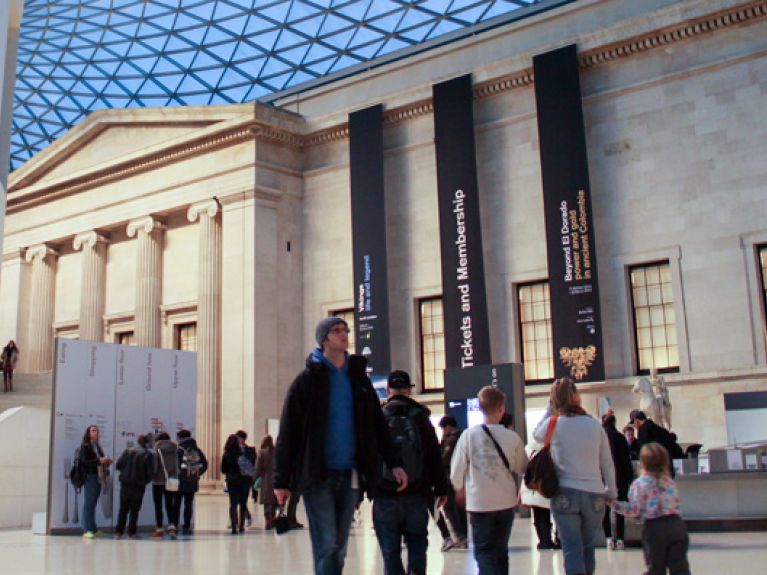Germany at the British Museum
An impressive exhibition at the British Museum shows Germany in a new light.

Nietzsche once remarked that the Germans’ typical habit of asking “What is German?” will never die out. Now, because of developments in reunified Germany, this issue seems to have become important for the country’s neighbours too. At the moment the British are taking a closer look at this question with an exhibition at the British Museum called Germany: Memories of a Nation. It uses a selection of illustrative items to fathom out which components contributed towards the identity of the newly emerged Germany of 1990.
Up until now the focus in the media and in history lessons has been fixed on the twelve years of Hitler’s dictatorship. But the exhibition, which is accompanied by a BBC radio series with thirty original short talks, and a richly illustrated book, is now broadening the perspective by covering 600 years of German history reflecting both the many triumphs and tragedies. The British are suddenly getting to know a different Germany. For many people the project is something of a revelation. It is as if a dam of accumulated misunderstandings has been broken.
The years 2014 and 2015 mark a number of relevant anniversaries in German-British relations. They include 300 years of German-British royal ties between the House of Hanover and Britain as well as the fall of the Berlin Wall 25 years ago. So, why has the British Museum chosen this approach rather than a backward-looking historical review? On the one hand, the idea of offering people food for new thoughts about Germany and its role in Europe is rooted in the museum’s founding concept of enlightenment; on the other hand, it can be attributed to the worldview of director Neil MacGregor, a master of associative communication. He would like to change the traditional image of Germany in the eyes of the British. Mr MacGregor says it is the task of the British Museum to help people understand the world – and without the most important country in Europe, we cannot understand the world of today. This project lies close to his heart.
In the exhibition, Neil MacGregor and the team of curators under Barrie Cook use individual objects and key themes to reflect on the diverse manifestations of the German nation since the late Middle Ages. They illuminate not only political structures, key historical events and cultural achievements, but also specific characteristics, such as the love of the forests that became rooted in the German soul by the Romantic movement and the tradition of precision engineering and skilled craftsmanship enshrined in the astronomical clock at Strasbourg cathedral, the “white gold” of the Meissen porcelain factory or the VW Beetle.
The exhibition also shows the use of great craftsmanship for evil purposes with the horrific example of the iron gate to Buchenwald concentration camp. Wrought in Bauhaus script, the cynical motto on the gate deliberately distorted a principle in Roman law: To Each What They Are Due. Neil MacGregor writes: “More than any other object in this story of Germany, the Buchenwald gate, erected almost within sight of Weimar and everything for which Weimar stands, brings us back to the unanswered, perhaps unanswerable question: how could it happen? How did the great humanising traditions of German history – Dürer, Luther’s bible, Bach, the Enlightenment, Goethe’s Faust, the Bauhaus, and much, much more – fail to avert this total ethical collapse, which led to the murder of millions and to national disaster?”
Mr MacGregor thinks that a German exhibition organiser would have found himself under pressure to offer an explanation for the inexplicable. But as a foreigner, he himself is able to refrain from any comment. In the exhibition, the path to catastrophe is traced throughout the eloquent arrangement of objects without the slightest indication of moral preaching: Tischbein’s portrait of Goethe in the Campagna, a Bauhaus cradle, and the Buchenwald gate. The question how all of this could happen in one place buries itself in the mind with gnawing persistence. MacGregor’s subtle method gradually becomes clear: he takes artefacts and observes them like a geologist who reads the Earth’s history of evolution from the sediments. MacGregor coaxes out the multilayered meanings of an object and in so doing reveals its spectrum of suggestive power. In this way, each exhibit becomes a symbol. A determining factor in his approach is the high esteem he expresses for the way people in Germany contemplate the past in relation to the future. Neil MacGregor’s project is based on the conviction that the dialogue of the living with the dead can help us to find our bearings in the present and to shape the future. Germany: Memories of a Nation can also be interpreted as an effort by Neil MacGregor to enlighten his Eurosceptic compatriots and allay their fear of the Teutons.
The main aim of the exhibition is to show visitors that there is no single German history. Instead there are many different German histories resulting from changing national borders and federal structures. This is vividly illustrated at the start of the exhibition with a showcase containing a map. Britain is represented by a single British gold coin, whilst a huge diversity of silver talers are scattered throughout the fragmented states of Germany, each of which bears the individual stamp of the respective princes, bishops, abbots or cities ruling under the sway of the Holy Roman Emperor. The thread of the exhibition focuses on this decentralisation which continues into the present and on the tradition of consensus which is essential for cooperation and cohesion among the many parts of the state. In this way visitors can begin to understand why the effects of embedment in the European Union are different in the cases of federal Germany and Britain.
The positive response to Germany: Memories of a Nation shows how remarkably the image of Germany has changed in Britain over the past 25 years. Until quite recently, it was an almost integral part of any German ambassador’s job in London to complain about the British obsession with Hitler, about the endless repetition of Teutonic clichés and stereotypes, the lacking perception of post-war Germany, not to mention the pages of the tabloids that were still being populated with goose-stepping ruffians wearing spiked or steel helmets. Germany: Memories of a Nation not only marks the climax of a process that has been underway since the 2006 FIFA World Cup, it also sets a new milestone for the future. A few years ago it would have been unimaginable that the British, as now during a conference flanking the exhibition, would have accused the Germans of shying away from their leadership position. Or that the historian Timothy Garton Ash would have attested that the Germans now feel relatively comfortable with their identity – in contrast to the British, who are currently going through an identity crisis. When the exhibition was in the planning phase, no German company was willing to act as sponsor. Now that virtually everyone is talking about Germany, and the numbers of visitors to the British Museum are endorsing the success of the BBC series, some of the senior executives at German subsidiaries may well be regretting their lack of confidence. In contrast, Neil MacGregor’s publisher has displayed a keener instinct for the growing interest in Germany and has printed 60,000 copies of the book in its first edition. ▪

